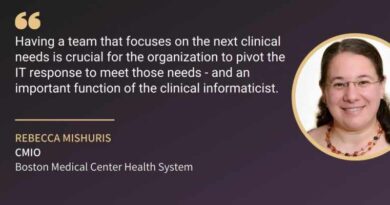How to address COVID-19 Pandemic using “All Hands on Deck” approach?
By Stacey Johnston, MD VP & CMIO, Baptist Health
During a time of crisis, such as the COVID-19 pandemic, healthcare organizations must rely on an “All Hands on Deck” approach. However, what has this meant for those that support their healthcare organization via the organization’s information technology? It likely meant the Information Systems (IS) department was even busier developing new processes, implementing new technologies, and supporting more users as the pandemic approached. Team members needed to remain strong to meet the needs of our patients and our communities. However, it also meant that we all had to keep our team members safe and fully informed.
At Baptist Health, we were in the early stages of our telemedicine journey prior to the COVID-19 pandemic. We understood that we would need to incorporate telemedicine models into our strategic plan for growth and sustainability. I sometimes joke that we implemented five years of strategic plans for telemedicine in five weeks. We deployed telemedicine via Zoom for all of our ambulatory clinics, including specialties such as psychiatry and cardiology, in just two weeks. We quickly deployed telemedicine for pediatric and adult rehabilitation services, including physical, occupational, and speech therapy. One of the challenges we faced was determining how we could utilize telemedicine for our inpatients. After many hours of pilots and process evaluation, we were able to deploy telemedicine for the inpatient providers using Zoom and an iPad on a cart for tele-ICU rapid assessment, wound care consults, and dietary requests. We developed a strategy where each COVID-19 patient had an iPad in the room so hospitalists could meet with the patients virtually to minimize exposure and save Personal Protective Equipment (PPE). Finally, we enhanced the patient experience by promoting Zoom virtual visits with loved ones while the inpatient units had visitor restrictions to keep our patients and our staff safe.
As an IS leader, my lesson learned was the primary emphasis is on the importance of our people, rather than technology.
Baptist Health was in early discussions about beginning a work-from-home program prior to the pandemic. Several analysts worked remotely, enabling us to recruit top talent. However, we were also evaluating how work-from-home could be applied to other areas in order to have increased employee satisfaction. An announcement was made that work that was not essential to be on-site should be remote. We had to evaluate what could be done remotely and to further assess how to stand up the necessary infrastructure required for a remote workforce for an entire organization of over 12,000 team members. We supported the transition of our employees to a remote workforce by increasing the number of VPN licenses, purchasing laptops, and enabling Webex and Zoom technologies.
To support the deployment of these technologies, IS team members, from executive assistants to project managers, went to our temporary storage location to open up boxes and set up iPads on carts, Work Station on Wheels (WOWs), and laptops with Nuance microphones. We wanted to ensure the bedside caregivers were not limited by the technology, but rather have an expanded reach because of the technology.
Our Clinical Informaticists (CI) and analysts were essential to the support of the organization. They designed new rules to minimize the clinician risk of exposure, developed lab orders, created order sets specific to caring for COVID-19 patients, and streamlined documentation templates. They also designed, built, and validated COVID-19-specific reporting tools to track and monitor our patients.
Additionally, we evaluated whether the nurse informaticists could serve in a patient-care capacity, and if any additional training would be necessary. It was ultimately decided that the nurse informaticists could serve patients by manning the drive-thru testing site, where they swabbed potential COVID-19 patients in a tent equipped with appropriate PPE.
As an IS leader, my lesson learned was the primary emphasis is on the importance of our people, rather than technology. “All hands on deck” was asking myself what I could give to my team members during this time of crisis. During this time of working extended hours to support the organization, our employees were and will continue to be at risk of feeling fatigued and isolated. I tried to think of new, virtual ways to make my team feel appreciated and engaged. I hosted a virtual “Town Hall” at the end of every week. To do this, the first requirement was to ensure video capabilities were turned on for all team members. The second creative challenge was to come up with a theme everyone could participate in. The themes included superheroes, with appearances by Superwoman, Spiderman, and, of course, many nurses (the real superheroes!). My favorite theme was the “Tiger King.” It was a fun way for me to communicate important updates about COVID-19 with all of my team members while allowing for a little levity and togetherness in a time of social isolation.
It is important to tell your team members, although they may not be the ones performing the telemedicine visits with patients, they have impacted the care of those individuals by developing and testing the process. The team members who deployed the WOWs, iPads on carts, and laptops are very much a part of the care team. We made an impact every day, keeping the workforce safe by supporting the capability to work from home and facilitating virtual provisioning care. It is also important to remind your team to take time to care for themselves. We sent daily system-wide communication with simple self-care steps, including tips for eating healthy and reminders to spend time outside. In fact, several rest-and-revive tents were set up throughout the organization for team members to recover in a relaxing setting surrounded by soothing music and support of our Baptist Behavioral Health and Spiritual Care team.
Now, we must look to the future. We need to think about how to restart the physical organization, but also how to adjust to the changing paradigm of health care in which telemedicine is a new reality. Baptist Health successfully maximized the care of our COVID-19 patients by developing a home-monitoring program utilizing home health nurses via telemedicine visits with our primary care physicians. We will need to expand these innovations into the future by developing a “Hospital at Home” program utilizing digital monitoring devices. We should all be evaluating how we can develop a telemedicine workforce dedicated to monitoring patients for disease states beyond COVID-19, using digital devices and telemedicine visits.
The impact each of us has had on our organizations will last long after COVID-19. I was just lucky to be a part of it, at Baptist Health, and as a teammate of health professionals throughout America.



